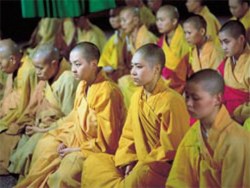Difference between revisions of "Nun"
| Line 4: | Line 4: | ||
| − | A [[nun]] (bhikkhuṇī) is a woman who has renounced ordinary {{Wiki|society}} to [[live]] a [[celibate]] [[monastic]] [[life]]. | + | A [[nun]] (bhikkhuṇī) is a woman who has renounced ordinary {{Wiki|society}} to [[live]] a [[celibate]] [[monastic]] [[life]]. As in [[Theravadin]] countries, [[Tibetan]] women practitioners (generically called [[ani]]) could not traditionally attain the full ordination of [[bhikshuni]], since the [[ordination lineage]] was held to have died out. There were numerous communities of [[ani]], but there were fewer of them than male monastics and their status was lower. |
Revision as of 01:55, 24 September 2018
A nun (bhikkhuṇī) is a woman who has renounced ordinary society to live a celibate monastic life. As in Theravadin countries, Tibetan women practitioners (generically called ani) could not traditionally attain the full ordination of bhikshuni, since the ordination lineage was held to have died out. There were numerous communities of ani, but there were fewer of them than male monastics and their status was lower.
The contemporary terms ‘female monk’ or ‘female priest’ are misnomers.
Nuns are the second of the four members of the Buddhist community (parisā), the others being monks, lay men and lay women.
To be properly ordained, a nun must be ordained first by a quorum of monks and then a second time by a quorum of nuns.
Some nuns in the scriptures are described as being learned (bahussuta), eloquent (bhāṇika), confident (visārada) and outstanding at teaching the Dhamma (paṭṭha dhammaṃ kattaṃ katuṃ, Vin.IV,290).
At the time of the Buddha nuns were usually addressed both by other nuns and by lay people as ‘noble lady’ (ayye). Monks would usually address them as ‘sister’ (bhaginī).
In Theravāda lands, the nun’s lineage died out around the turn of the first millennium and traditionalists do not believe that it can or should be revived because there are no nuns to ordain new nuns.
However, the nuns’ lineage continues in most Mahāyāna countries, and in places like Taiwan, nuns are a dynamic and respected presence within the Buddhist community.
See Household Life and Mahā Pajāpatī Gotamī.
Women Under Primitive Buddhism, I. B. Horner, 1990.
